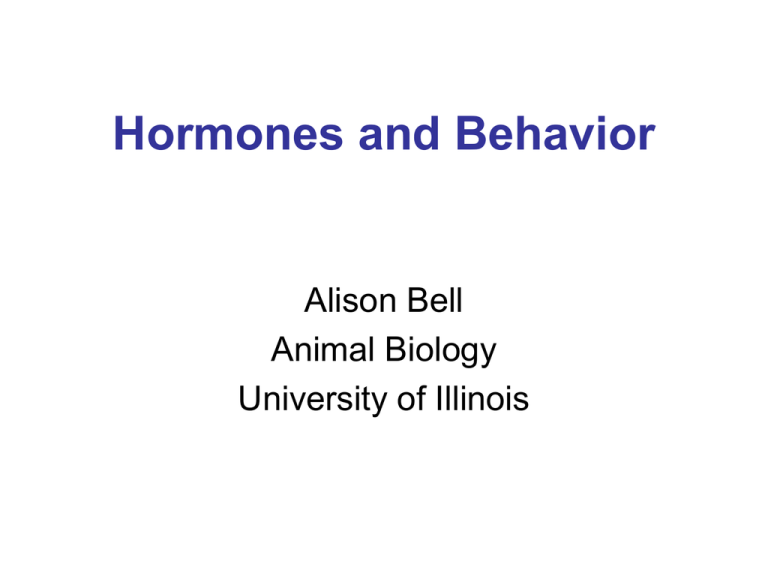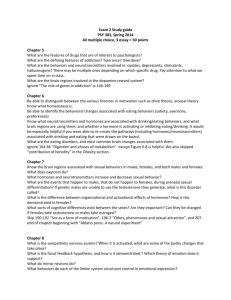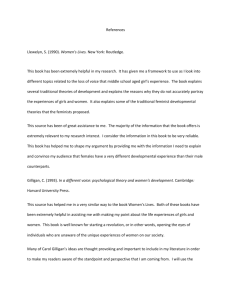Hormones & Behavior
advertisement

Hormones and Behavior Alison Bell Animal Biology University of Illinois Today’s lecture • Hormones – What are they? – Where are they made? – What do they do? • Hormones and behavior – Organization-activation • Relative plasticity hypothesis – In utero and parental effects – Challenge hypothesis Hormones: What are they? • Chemical substances, formed in a specialized gland or group of cells, released into the blood that affect target cells in another organ. Distinct from: •Neurotransmitters, substances released by neurons that are received by adjacent neurons & alter their membrane potential. •Pheromones, substances released by an individual as scent signals for another. Hormones: What are they? Testosterone Chemically, they can be: – Lipids (e.g. steroids such as testosterone) – Peptides/proteins (e.g. vasopressin) – Amines/other small molecules (e.g. epinephrine) Hormones: Where are they made? • Peripherally – Endocrine glands, e.g. adrenal gland, thyroid gland – Gonads, e.g. testes, ovaries • Centrally – ‘Neurohormones’ are produced within the brain, but travel to target via bloodstream • e.g. hypothalamus, neurosteroidogenic cells Hormones: What do they do? Nonsteroid hormones: can’t enter cell Steroid hormones: pass right through • Many physiological effects: regulation of reproduction, growth, osmotic balance, heart rate, etc. • In the brain: influence neuronal responsiveness, or activity of certain genes within the neuron, thus altering the biochemistry of the brain to alter behavior Hormone regulation: Important vertebrate pathways Hypothalamus-pituitary-gonad (HPG) Hypothalamus-pituitary-adrenal (HPA) Hormone regulation: Synthesis and metabolism Bells and whistles: Receptors Plasma binding proteins Enzymes How to study hormones? • Remove the gland • Add hormone • Measure circulating levels • Block receptor Sexual Behavior: Females • Estradiol and mice – OVX mice: eliminates female sexual behavior (lordosis) – Can be restored by treatment with estradiol followed by progesterone Estradiol Sexual Behavior: Males Red deer stag – Sept/Oct become aggressive, begin courting females – Testes generate sperm and release testosterone – Castrated males do not fight or mate – Testosterone implants restore behavior Hormones If a male and female ring dove are placed in a cage containing a bowl and nesting material, and kept in simulated spring, they will initiate the following sequence: bow and coo display, where the male bows and coos to the female select a nest site, marked by the female sitting on it build the nest – takes one week copulate during nest building female lays eggs, 2 eggs over 2 days incubate the eggs – takes two weeks the young hatch and the parents feed the young by producing a “crop milk” and regurgitating it for the young – takes two weeks initiate sequence again Behavior Role of progesterone… Lehrman 1964 Important point • Many shared mechanisms, BUT mechanisms often differ between species/groups – Different selection pressures result in modifications of the hormonal mechanisms of behavior Hunt et al 1995 Modes of Hormone Action • Activational effects – Short-term, reversible effects that occur in the fully developed organism (e.g. alteration of transmission in neural networks that respond to certain aspects of the environment) • Organizational effects – Long-term, irreversible effects on tissue differentiation and development (e.g. brain, ovary) that can either directly (brain) or indirectly (ovary) influence behavior • Critical or sensitive period Activational Effect • Oxytocin and maternal behavior in mice – Pre-maternal mice fear pups and will attack them – Oxytocin injections induce maternal behavior Another activational example • Oxytocin and maternal behavior in sheep – Stimulation of birth canal during parturition results in oxytocin release in brain – Oxytocin injections cause non-pregnant females to accept alien lambs in 30 seconds! Dolly the sheep and her surrogate mom Organizational Effect Sexual differentiation via exposure to steroids during development Figure 1. Sexual dimorphisms in the brain. (a,b) The sexually dimorphic nucleus of the preoptic area (SDN-POA) is larger in male rats (a) than in females (b) because the testes secrete testosterone during the perinatal sensitive period. After that time, testosterone has little effect on SDN-POA volume. (c,d) In contrast, the volume of the rat posterodorsal medial amygdala (MePD), which is about 1.5 times larger in males (c) than in females (d), retains its responsiveness to testosterone throughout life. (e,f) In zebra finches, the robustus archistriatum (RA) nucleus is crucial for song production and has a greater volume in males (e) than in females (f). Like the rat SDN-POA, exposure to steroid hormones early in life is essential for the RA to develop a masculine phenotype. For the RA, however, the steroids may not originate from the testes, but are rather synthesized locally in the brain itself. SCN, suprachiasmatic nucleus; 3V, third ventricle; ot, optic tract. All scale bars = 250 mum. Morris et al 2004 Applying organization-activation theory to alternative phenotypes The relative plasticity hypothesis Alternative phenotypes – within-sex variation in phenotype (morphology, behavior), e.g. sneakers vs territorial males Fixed: individual permanently, irreversibly differentiated into one or the other type and doesn’t change phenotype during lifetime, e.g. satellite vs territorial ruffs, hooknose or jack salmon Plastic: individual can change phenotype, e.g. calling vs intercepting frogs depending on local conditions Moore et al 1998 The relative plasticity hypothesis Moore et al 1998 Effects of exposure to hormones on behavioral development Mice and aggressiveness – Subtle differences in the hormonal environment during embryonic development influence adult behavior – E.g. Males: 2M more aggressive later on. – E.g. Females: 2M more aggressive (correlated with territory size as adults) – Vom Saal et al Another interesting way in which developing embryos are exposed to hormones… Gil et al 1999, zebra finches Females mated to relatively attractive males deposited more testosterone in their eggs compared to females mated to unattractive males The differential allocation hypothesis (Burley 1988) Testosterone in male birds What explains the dynamics (change over time) of T? Costs of T Aggression T Parental behavior Level of behavior The challenge hypothesis In species where males provide direct parental care (feed the chicks), males should increase T only when needed, e.g. when challenged, but then return T to level B. In contrast, in species where males do not provide direct parental care and spend most of their time defending the territory, males should have high, relatively unchanging, levels of T. Wingfield et al 1990 Closer to home: hormones and human behavior Undoubtedly, hormones involved in organizing and activating human sexual behavior What about unique human behaviors? Testosterone and aggression • Some studies find higher T in CSF of aggressive males – Meta-analysis of 45 studies: weak, positive correlation between T & aggressiveness – May be more related to “dominance” – Serotonin may be more important in aggression • Ritualized aggression? – Men experience a surge in T after team/individual wins in sports – World Cup soccer fans show increased T if their team wins







